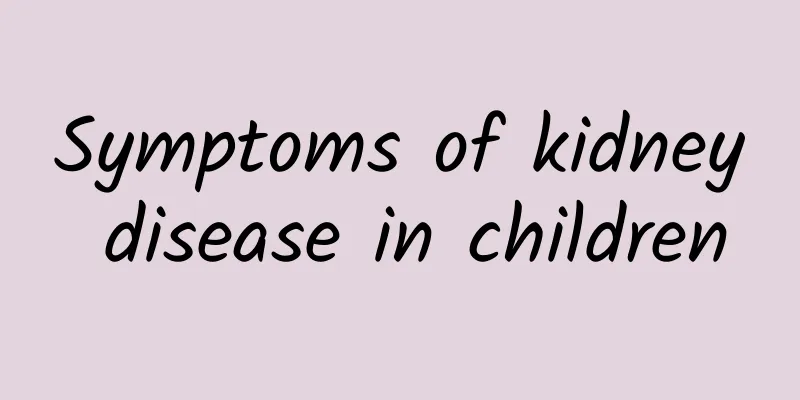What foods should children with pneumonia avoid eating? What tests should be done for children with pneumonia?

|
Pneumonia is a common disease, and children are the most susceptible to this disease. Many children suffer from pneumonia in life, which has an impact on their physical health. The treatment of this disease takes a long time and is difficult. Therefore, when we find that a child has pneumonia, we must go to the hospital for corresponding examinations to determine the treatment method. The following is an introduction to what examinations are needed for pediatric pneumonia: (1) Sputum culture and drug sensitivity test Through sputum culture, the type of pathogenic bacteria can be detected, so that appropriate drugs can be selected for treatment. The drug sensitivity test is used to measure drug sensitivity so that drugs can be used for treatment accurately and effectively. In addition, during the epidemic period of mycoplasma pneumonia, cold agglutination test should be performed to diagnose mycoplasma infection. Cold agglutination test is mainly used for auxiliary diagnosis of primary atypical pneumonia caused by mycoplasma pneumoniae. (2) Routine blood test Routine blood test is the most common and basic blood test. Blood is composed of two major parts: liquid and visible cells. Routine blood test tests the cell part of blood. Diseases can be judged by observing the changes in quantity and morphological distribution. It is one of the commonly used auxiliary examination methods for doctors to diagnose diseases. This includes the total number of white blood cells and neutrophils, lymphocytes, eosinophils, etc. White blood cells are important defense weapons in the human body. When pathogens invade the body, white blood cells can phagocytize and eliminate the pathogens. Therefore, the nature of the infection, the body's response state and the prognosis can be roughly estimated from the total number of white blood cells, classification and morphological changes. The total white blood cell count in children with bacterial pneumonia is usually increased, generally reaching (15-30)×109/L, and the neutrophil count is 60%-90%. In viral pneumonia, the total white blood cell count is mostly normal or low. (3) X-ray examination X-ray examination is often used as one of the auxiliary examination methods in medicine. There are two common X-ray examination methods in clinical practice: fluoroscopy and radiography. Fluoroscopy is more economical and convenient, and the examined part can be changed at will for multi-faceted observation, but it cannot leave an objective record and it is not easy to distinguish details. Radiography can make the structure of the examined part clearly displayed on the X-ray film, and can be kept for a long time as an objective record, so that it can be studied at any time when necessary or compared during reexamination. If necessary, special X-ray examinations can also be performed, such as tomography, kymographs, and contrast examinations. The choice of X-ray examination method must be based on the specific situation of the examination, the requirements for solving the disease and clinical needs. X-ray examination is only one of the clinical auxiliary diagnosis methods. Children with pneumonia will cough and bear weight when breathing after birth. Parents should pay attention to taking good care of their children and not let the condition get worse. So, what dietary taboos should children with pneumonia pay attention to? Avoid greasy and heavy flavors Children with pneumonia often have low digestive function. If they eat greasy and heavy food, their digestive function will be affected, and the necessary nutrients will not be replenished in time, resulting in reduced resistance to disease. Therefore, they should not eat cod liver oil, pine egg yolk, crab roe, phoenix tail fish, crucian carp roe, and animal offal. If they drink milk, the upper oil film should be removed, and nursing mothers should also eat less greasy food to avoid aggravating the condition. Avoid high-protein diet The main components of lean meat, fish and eggs are proteins. 1 gram of protein absorbs 18 milliliters of water in the body, and the final product of protein metabolism is urea. Children who eat more protein will excrete more urea, and every 300 milligrams of urea excreted will take away at least 20 milliliters of water. Therefore, children with high fever and dehydration should avoid eating high-protein diets, and they can supplement them appropriately in the later stages of the disease to improve their physical fitness. Avoid eating foods with high sugar content Sugar is a calorie supplement with a simple function and basically contains no other nutrients. If children with pneumonia eat more sugar, the bactericidal effect of white blood cells in the body will be inhibited. The more sugar they eat, the more obvious the inhibition will be, which will aggravate the condition. Avoid spicy food Spicy foods are very irritating and can easily generate heat and damage body fluids. Therefore, children with pneumonia should not add chili oil, pepper, and spicy condiments to their diet. |
Recommend
What should be done to check for acute laryngitis in children
What kind of examinations should be done for acut...
How to treat eczema in children? There are 3 treatment methods
Children with eczema need to choose medication fo...
Can children with pneumonia not eat protein? Children with pneumonia should follow three dietary principles
Children's bodies are relatively fragile and ...
Prevention methods for children's pneumonia in spring
Pneumonia is generally caused by infection. Of co...
What are the symptoms and manifestations of hand, foot and mouth disease in children? When is the peak period of hand, foot and mouth disease?
Hand, foot and mouth disease is a common disease ...
How to check pneumonia in children
If the living environment is not very good, it is...
What is the modern treatment for breast milk diarrhea?
What is the modern treatment for breast milk diar...
How to cure diarrhea in children
Newborns are just born, their body functions are ...
What should children with kidney disease pay attention to?
Pediatric nephritis is one of the most common dis...
What are the dangers of zinc deficiency and what are the symptoms of zinc deficiency
We need to take in some nutrients we need through...
How high is jaundice likely to cause cerebral palsy
Neonatal jaundice is a common physiological pheno...
Typical symptoms of diarrhea in children
Infants and young children are a vulnerable group...
Diagnosis of congenital megacolon in children What are the symptoms of congenital megacolon in children
Measuring the reflex pressure changes of the rect...
The best way to prevent pneumonia in children
Speaking of the best measures to prevent childhoo...
How to effectively prevent pneumonia and how to properly care for children with pneumonia?
The main symptoms of pneumonia include fever, cou...









